It's Disney December at EFSP, and today we have the 14th animated feature film from the Disney canon, Peter Pan (Clyde Geronimi, Wilfred Jackson, Hamilton Luske, 1953). The film was based on the 1904 play 'Peter Pan, or The Boy Who Wouldn't Grow Up' by J. M. Barrie. Peter Pan travels from the enchanted isle of Never Land all the way to London just to hear Wendy Darling spin tales about him and his adventures. While his ego may seem inflated at times, even his arch-nemesis Captain Hook knows that Peter's no ordinary boy. He can fly without wings and match Hook's cutlass with nothing more than a dagger. He is also the undisputed leader of the Lost Boys and allows no breaks in ranks. Time makes little difference to him; when you never grow up, life is nothing but fun, whimsy, and adventure...

English postcard by The Art Group Ltd. in The Disney Archive Collection, no. 8763. Image: Disney. Publicity still for Peter Pan (Clyde Geronimi, Wilfred Jackson, Hamilton Luske, 1953). Caption: Wendy sews Peter's shadow back on.

English postcard by The Art Group Ltd., no. 8758. Image: Disney. Publicity still for Peter Pan (Clyde Geronimi, Wilfred Jackson, Hamilton Luske, 1953). Caption: And away they all flew to Neverland.

Vintage postcard in the Disney Classics series by European Greetings, no. 535552. Image: Walt Disney. Tinker Bell in Peter Pan (Clyde Geronimi, Wilfred Jackson, Hamilton Luske, 1953). Sent by mail in 1997.
In 1935, Walt Disney could not get the rights of the play 'Peter Pan' until four years later after he came to an arrangement with Great Ormond Street Hospital in London, to whom J. M. Barrie had bequeathed the rights to his play.
The Disney studio started the story development and character designs in the late-1930s and early-1940s and intended it to be Disney's fourth feature film, after Snow White and the Seven Dwarfs, Bambi and Pinocchio. Bambi was later put on hold for a short while for technical difficulties and ended up being his fifth film while Pinocchio became Disney's second film.
During this time Disney explored many possibilities of how the story could be interpreted. In the earliest version of the story, the film started by telling Peter Pan's back story.
But in May 1940, during a story meeting, Disney said "We ought to get right into the story itself, where Peter Pan comes to the house to get his shadow. That's where the story picks up."
Disney also explored the idea of opening the film in Never Land with Peter Pan coming to Wendy's house to kidnap her as a mother for the Lost Boys. Eventually, Disney decided that the kidnapping plot was too dark, and he went back to Barrie's original play in which Peter comes to get his shadow and Wendy is eager to see Never Land.
In December 1941, the United States joined the Second World War after Pearl Harbor was attacked. The following day the U.S military took control of the studio and commissioned them to produce war propaganda films. They also forced Peter Pan as well as Alice in Wonderland, The Wind in the Willows, Song of the South, Mickey and the Beanstalk, and Bongo, among others, to be put on hold.
After the war ended in 1945, the studio was in debt and they could only produce package films to support themselves. It was not until 1947, as the studio's financial health started to improve again, that the actual production of Peter Pan commenced, even though Roy O. Disney did not think that Peter Pan would have much box office appeal.

American postcard by Disneyland, Anaheim, California. Image: Walt Disney Productions. Caption: Tinker Bell sprinkles magic stardust over the wonderful world of Fantasy called Disneyland - to make it truly "the happiest place on earth".

Belgian postcard by Editions Corna, Brussels, no. 3313. Image: Walt Disney Productions. Publicity still for Peter Pan (Clyde Geronimi, Wilfred Jackson, Hamilton Luske, 1953).
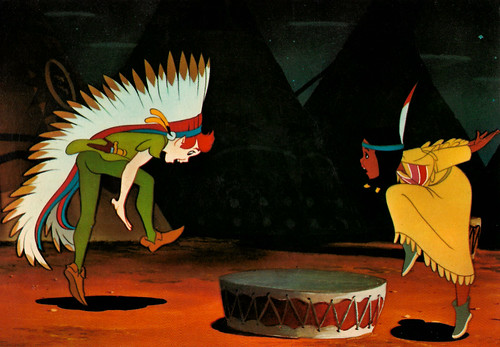
French postcard by Editions G. Picard, Paris, no. WD 2/20, 1978. Image: Walt Disney Production.
Peter Pan (Clyde Geronimi, Wilfred Jackson, Hamilton Luske, 1953) is the final Disney animated feature released through RKO before Walt Disney's founding of his own distribution company, Buena Vista Film Distribution, later in 1953 after the film was released.
Peter Pan is the final Disney film in which all nine members of Disney's 'Nine Old Men' worked together as directing animators. According to researcher Neal Gabler and animator Frank Thomas, a board was formed to study all possible problems affecting the company in relation to its work between 1945 and 1947. One day in the early 1950s, there were nine members on the board and Walt Disney named the group "Nine Old Men".
The Nine Old Men were the core animators Les Clark (animator of Mickey Mouse), Marc Davis (Bambi and Thumper in Bambi), Ollie Johnston (Mr. Smee in Peter Pan), Milt Kahl (villains such as Shere Khan in The Jungle Book), Ward Kimball (Jiminy Cricket in Pinocchio), Eric Larson (Peter Pan's flight over London to Neverland), John Lounsbery (George Darling in Peter Pan), Wolfgang Reitherman (the Crocodile in Peter Pan), and Frank Thomas (Captain Hook in Peter Pan).
Peter Pan is also the second Disney animated film starring Kathryn Beaumont (as Wendy), Heather Angel (as Mrs. Darling), and Bill Thompson (as Mr. Smee) after their roles in the animated feature Alice in Wonderland (Clyde Geronimi, Wilfred Jackson, Hamilton Luske, 1951). Child star Bobby Driscoll did Peter Pan's voice.
Peter Pan got mainly positive reviews from the critics. The New York Times gave the film a mixed review, praising the animation itself, but also declaring that the film was not really true to the spirit of the original Barrie play. However, Time Magazine gave the film a highly favourable review, making no reference to the changes from the original play.
The film was entered into the 1953 Cannes Film Festival. During its initial box office run, the film was a moderate success and it grossed $7 million in domestic rentals. After its original theatrical run, it was re-released theatrically in 1958, 1969, 1976, 1982, and 1989. The film has earned a lifetime domestic gross of $87.4 million.
While not a big hit at first, Peter Pan is now considered to be one of the most well known Disney films of all time. A sequel titled Return to Never Land was released in 2002, and a series of direct-to-DVD prequels focusing on Tinker Bell began in 2008. A preschoolers' television series featuring some of the characters, Jake and the Never Land Pirates, premiered in 2011.
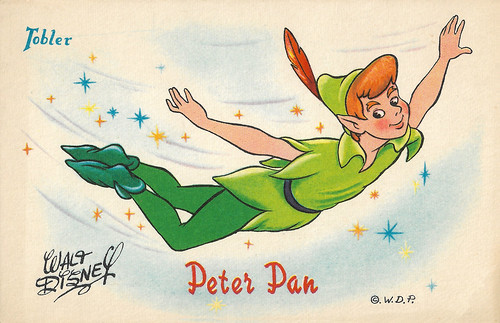
French postcard by Imp. Georges Lang, Paris, offered by Chocolats Tobler. Image: Walt Disney.
Peter Pan travels from the enchanted isle of Never Land all the way to London just to hear Wendy Darling spin tales about him and his adventures. While his ego may seem inflated at times, even his arch-nemesis Captain Hook knows that Peter's no ordinary boy.

French postcard by Imp. Georges Lang, Paris, offered by Chocolats Tobler. Image: Walt Disney.
Wendy Darling is a young girl from London with a lifelong appreciation for the stories of Peter Pan. She lives with her parents, George and Mary, her brothers, Michael and John, as well as their dog Nana, who doubles as the children's daily caretaker when their parents are absent on their dates or parties.

French postcard by Imp. Georges Lang, Paris, offered by Chocolats Tobler. Image: Walt Disney.
John Darling is the brother of Wendy and Michael Darling.

French postcard by Imp. Georges Lang, Paris, offered by Chocolats Tobler. Image: Walt Disney.
Michael Darling is the brother of Wendy and John Darling. He is the youngest child of the three Darling children.
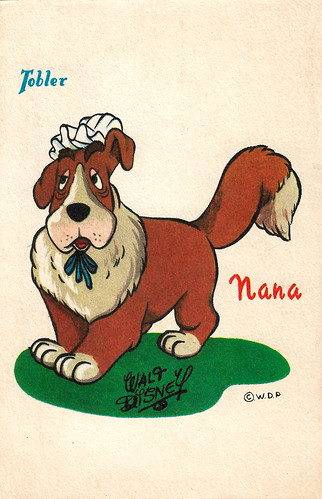
French postcard by Imp. Georges Lang, Paris, offered by Chocolats Tobler. Image: Walt Disney.
Nana is a St. Bernard who is the nursemaid of the Darling children.

French postcard by Imp. Georges Lang, Paris, offered by Chocolats Tobler. Image: Walt Disney.
Tinker Bell (also nicknamed Tink or Miss Bell) is a sassy fairy, who regularly joins Peter on his exploits throughout the magical isle of Neverland. In 2008, she got her very own film, Tinker Bell (Bradley Raymond, 2008).

French postcard by Imp. Georges Lang, Paris, offered by Chocolats Tobler. Image: Walt Disney. Foxy in Peter Pan (Clyde Geronimi, Wilfred Jackson, Hamilton Luske, 1953).
In Neverland, an ongoing war is taking place between Peter's gang of rag-tag runaways, the lost boys, and the evil pirate Captain Hook. One of these lost boys is Foxy.
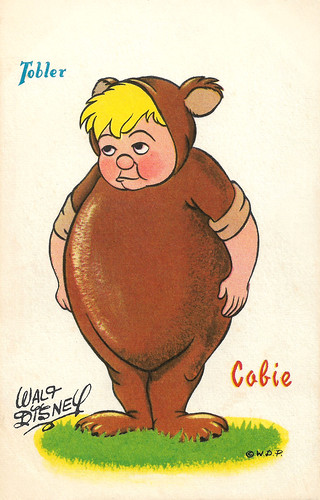
French postcard by Imp. Georges Lang, Paris, offered by Chocolats Tobler. Image: Walt Disney.
Cubby (in French Cobie) is also one of the lost boys.

French postcard by Imp. Georges Lang, Paris, offered by Chocolats Tobler. Image: Walt Disney. Indian Chief in Peter Pan (Clyde Geronimi, Wilfred Jackson, Hamilton Luske, 1953).
The Indian Chief (named Great Big Little Panther in the original play) is Tiger Lily's father and the leader of Neverland's indigenous tribe. When John, Michael, and the Lost Boys are out hunting Natives, they are captured by the Indian tribe instead and taken to the Native Camp and brought to the attention of the Chief, who thinks they've kidnapped his daughter Tiger Lily (who is actually kidnapped by Captain Hook).
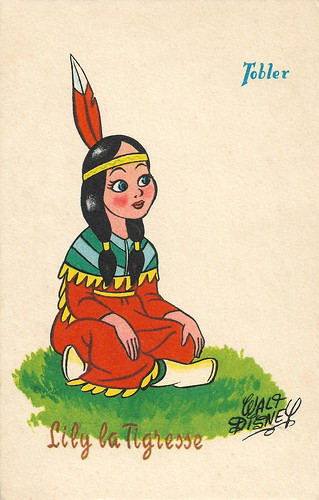
French postcard by Imp. Georges Lang, Paris, offered by Chocolats Tobler. Image: Walt Disney.
Princess Tiger Lily is the beautiful daughter of Neverland's indigenous chief. Tiger Lily is brave, strong-willed, and incredibly proud, and a loyal friend of Peter Pan.

French postcard by Imp. Georges Lang, Paris, offered by Chocolats Tobler. Image: Walt Disney.
Captain James Hook is the bloodthirsty commander of the Jolly Roger, and the scourge of Neverland. Hook has abandoned sailing the high seas in favour of having revenge on Peter Pan for cutting off his left hand and feeding it to a crocodile, who has since been in constant pursuit of the captain. While a worthy opponent for Peter, Hook is destined to fail, sometimes because of Peter Pan's ability to fly, but more often through the bumbling actions of his first mate, Mr. Smee, who while unquestioningly faithful to the captain, is incompetent and flimsy.
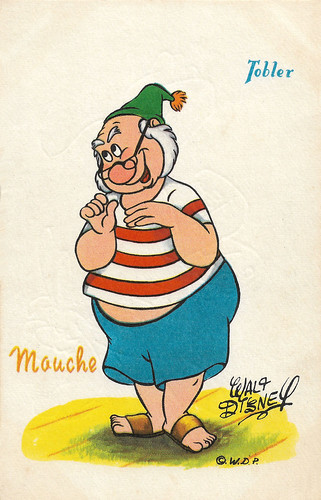
French postcard by Imp. Georges Lang, Paris, offered by Chocolats Tobler. Image: Walt Disney.
Mr. Smee is Captain Hook's loyal first mate and henchman in Disney's Peter Pan (Clyde Geronimi, Wilfred Jackson, Hamilton Luske, 1953). However, Smee's bumbling behaviour often prevents him from being much help.
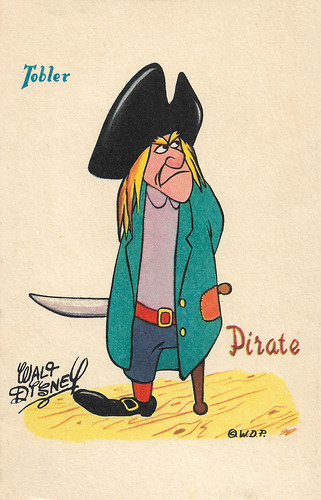
French postcard by Imp. Georges Lang, Paris, offered by Chocolats Tobler. Image: Walt Disney.
This Pirate is Bill Jukes, a.k.a. "Peg-Leg", one of Captain Hook's pirate henchmen. He is among the crew of the Jolly Roger.

French postcard by Imp. Georges Lang, Paris, offered by Chocolats Tobler. Image: Walt Disney.
Tick-Tock the Crocodile (better known as just the Crocodile) is a croc of monstrous proportions that dwells on the isle of Neverland. After swallowing the hand of Captain Hook (who lost it while battling Peter Pan), Tick-Tock has been in pursuit of the villainous captain in hopes of devouring the rest of him. However, the crocodile also swallowed an alarm clock at some point, and its constant ticking acts as something of a warning for the ever-fearful Hook.
Sources: Disney Wiki, Wikipedia, and IMDb.

English postcard by The Art Group Ltd. in The Disney Archive Collection, no. 8763. Image: Disney. Publicity still for Peter Pan (Clyde Geronimi, Wilfred Jackson, Hamilton Luske, 1953). Caption: Wendy sews Peter's shadow back on.

English postcard by The Art Group Ltd., no. 8758. Image: Disney. Publicity still for Peter Pan (Clyde Geronimi, Wilfred Jackson, Hamilton Luske, 1953). Caption: And away they all flew to Neverland.

Vintage postcard in the Disney Classics series by European Greetings, no. 535552. Image: Walt Disney. Tinker Bell in Peter Pan (Clyde Geronimi, Wilfred Jackson, Hamilton Luske, 1953). Sent by mail in 1997.
Getting right into the story itself
In 1935, Walt Disney could not get the rights of the play 'Peter Pan' until four years later after he came to an arrangement with Great Ormond Street Hospital in London, to whom J. M. Barrie had bequeathed the rights to his play.
The Disney studio started the story development and character designs in the late-1930s and early-1940s and intended it to be Disney's fourth feature film, after Snow White and the Seven Dwarfs, Bambi and Pinocchio. Bambi was later put on hold for a short while for technical difficulties and ended up being his fifth film while Pinocchio became Disney's second film.
During this time Disney explored many possibilities of how the story could be interpreted. In the earliest version of the story, the film started by telling Peter Pan's back story.
But in May 1940, during a story meeting, Disney said "We ought to get right into the story itself, where Peter Pan comes to the house to get his shadow. That's where the story picks up."
Disney also explored the idea of opening the film in Never Land with Peter Pan coming to Wendy's house to kidnap her as a mother for the Lost Boys. Eventually, Disney decided that the kidnapping plot was too dark, and he went back to Barrie's original play in which Peter comes to get his shadow and Wendy is eager to see Never Land.
In December 1941, the United States joined the Second World War after Pearl Harbor was attacked. The following day the U.S military took control of the studio and commissioned them to produce war propaganda films. They also forced Peter Pan as well as Alice in Wonderland, The Wind in the Willows, Song of the South, Mickey and the Beanstalk, and Bongo, among others, to be put on hold.
After the war ended in 1945, the studio was in debt and they could only produce package films to support themselves. It was not until 1947, as the studio's financial health started to improve again, that the actual production of Peter Pan commenced, even though Roy O. Disney did not think that Peter Pan would have much box office appeal.

American postcard by Disneyland, Anaheim, California. Image: Walt Disney Productions. Caption: Tinker Bell sprinkles magic stardust over the wonderful world of Fantasy called Disneyland - to make it truly "the happiest place on earth".

Belgian postcard by Editions Corna, Brussels, no. 3313. Image: Walt Disney Productions. Publicity still for Peter Pan (Clyde Geronimi, Wilfred Jackson, Hamilton Luske, 1953).

French postcard by Editions G. Picard, Paris, no. WD 2/20, 1978. Image: Walt Disney Production.
The final film of the Nine Old Men
Peter Pan (Clyde Geronimi, Wilfred Jackson, Hamilton Luske, 1953) is the final Disney animated feature released through RKO before Walt Disney's founding of his own distribution company, Buena Vista Film Distribution, later in 1953 after the film was released.
Peter Pan is the final Disney film in which all nine members of Disney's 'Nine Old Men' worked together as directing animators. According to researcher Neal Gabler and animator Frank Thomas, a board was formed to study all possible problems affecting the company in relation to its work between 1945 and 1947. One day in the early 1950s, there were nine members on the board and Walt Disney named the group "Nine Old Men".
The Nine Old Men were the core animators Les Clark (animator of Mickey Mouse), Marc Davis (Bambi and Thumper in Bambi), Ollie Johnston (Mr. Smee in Peter Pan), Milt Kahl (villains such as Shere Khan in The Jungle Book), Ward Kimball (Jiminy Cricket in Pinocchio), Eric Larson (Peter Pan's flight over London to Neverland), John Lounsbery (George Darling in Peter Pan), Wolfgang Reitherman (the Crocodile in Peter Pan), and Frank Thomas (Captain Hook in Peter Pan).
Peter Pan is also the second Disney animated film starring Kathryn Beaumont (as Wendy), Heather Angel (as Mrs. Darling), and Bill Thompson (as Mr. Smee) after their roles in the animated feature Alice in Wonderland (Clyde Geronimi, Wilfred Jackson, Hamilton Luske, 1951). Child star Bobby Driscoll did Peter Pan's voice.
Peter Pan got mainly positive reviews from the critics. The New York Times gave the film a mixed review, praising the animation itself, but also declaring that the film was not really true to the spirit of the original Barrie play. However, Time Magazine gave the film a highly favourable review, making no reference to the changes from the original play.
The film was entered into the 1953 Cannes Film Festival. During its initial box office run, the film was a moderate success and it grossed $7 million in domestic rentals. After its original theatrical run, it was re-released theatrically in 1958, 1969, 1976, 1982, and 1989. The film has earned a lifetime domestic gross of $87.4 million.
While not a big hit at first, Peter Pan is now considered to be one of the most well known Disney films of all time. A sequel titled Return to Never Land was released in 2002, and a series of direct-to-DVD prequels focusing on Tinker Bell began in 2008. A preschoolers' television series featuring some of the characters, Jake and the Never Land Pirates, premiered in 2011.

French postcard by Imp. Georges Lang, Paris, offered by Chocolats Tobler. Image: Walt Disney.
Peter Pan travels from the enchanted isle of Never Land all the way to London just to hear Wendy Darling spin tales about him and his adventures. While his ego may seem inflated at times, even his arch-nemesis Captain Hook knows that Peter's no ordinary boy.

French postcard by Imp. Georges Lang, Paris, offered by Chocolats Tobler. Image: Walt Disney.
Wendy Darling is a young girl from London with a lifelong appreciation for the stories of Peter Pan. She lives with her parents, George and Mary, her brothers, Michael and John, as well as their dog Nana, who doubles as the children's daily caretaker when their parents are absent on their dates or parties.

French postcard by Imp. Georges Lang, Paris, offered by Chocolats Tobler. Image: Walt Disney.
John Darling is the brother of Wendy and Michael Darling.

French postcard by Imp. Georges Lang, Paris, offered by Chocolats Tobler. Image: Walt Disney.
Michael Darling is the brother of Wendy and John Darling. He is the youngest child of the three Darling children.

French postcard by Imp. Georges Lang, Paris, offered by Chocolats Tobler. Image: Walt Disney.
Nana is a St. Bernard who is the nursemaid of the Darling children.

French postcard by Imp. Georges Lang, Paris, offered by Chocolats Tobler. Image: Walt Disney.
Tinker Bell (also nicknamed Tink or Miss Bell) is a sassy fairy, who regularly joins Peter on his exploits throughout the magical isle of Neverland. In 2008, she got her very own film, Tinker Bell (Bradley Raymond, 2008).

French postcard by Imp. Georges Lang, Paris, offered by Chocolats Tobler. Image: Walt Disney. Foxy in Peter Pan (Clyde Geronimi, Wilfred Jackson, Hamilton Luske, 1953).
In Neverland, an ongoing war is taking place between Peter's gang of rag-tag runaways, the lost boys, and the evil pirate Captain Hook. One of these lost boys is Foxy.

French postcard by Imp. Georges Lang, Paris, offered by Chocolats Tobler. Image: Walt Disney.
Cubby (in French Cobie) is also one of the lost boys.

French postcard by Imp. Georges Lang, Paris, offered by Chocolats Tobler. Image: Walt Disney. Indian Chief in Peter Pan (Clyde Geronimi, Wilfred Jackson, Hamilton Luske, 1953).
The Indian Chief (named Great Big Little Panther in the original play) is Tiger Lily's father and the leader of Neverland's indigenous tribe. When John, Michael, and the Lost Boys are out hunting Natives, they are captured by the Indian tribe instead and taken to the Native Camp and brought to the attention of the Chief, who thinks they've kidnapped his daughter Tiger Lily (who is actually kidnapped by Captain Hook).

French postcard by Imp. Georges Lang, Paris, offered by Chocolats Tobler. Image: Walt Disney.
Princess Tiger Lily is the beautiful daughter of Neverland's indigenous chief. Tiger Lily is brave, strong-willed, and incredibly proud, and a loyal friend of Peter Pan.

French postcard by Imp. Georges Lang, Paris, offered by Chocolats Tobler. Image: Walt Disney.
Captain James Hook is the bloodthirsty commander of the Jolly Roger, and the scourge of Neverland. Hook has abandoned sailing the high seas in favour of having revenge on Peter Pan for cutting off his left hand and feeding it to a crocodile, who has since been in constant pursuit of the captain. While a worthy opponent for Peter, Hook is destined to fail, sometimes because of Peter Pan's ability to fly, but more often through the bumbling actions of his first mate, Mr. Smee, who while unquestioningly faithful to the captain, is incompetent and flimsy.

French postcard by Imp. Georges Lang, Paris, offered by Chocolats Tobler. Image: Walt Disney.
Mr. Smee is Captain Hook's loyal first mate and henchman in Disney's Peter Pan (Clyde Geronimi, Wilfred Jackson, Hamilton Luske, 1953). However, Smee's bumbling behaviour often prevents him from being much help.

French postcard by Imp. Georges Lang, Paris, offered by Chocolats Tobler. Image: Walt Disney.
This Pirate is Bill Jukes, a.k.a. "Peg-Leg", one of Captain Hook's pirate henchmen. He is among the crew of the Jolly Roger.

French postcard by Imp. Georges Lang, Paris, offered by Chocolats Tobler. Image: Walt Disney.
Tick-Tock the Crocodile (better known as just the Crocodile) is a croc of monstrous proportions that dwells on the isle of Neverland. After swallowing the hand of Captain Hook (who lost it while battling Peter Pan), Tick-Tock has been in pursuit of the villainous captain in hopes of devouring the rest of him. However, the crocodile also swallowed an alarm clock at some point, and its constant ticking acts as something of a warning for the ever-fearful Hook.
Sources: Disney Wiki, Wikipedia, and IMDb.
No comments:
Post a Comment